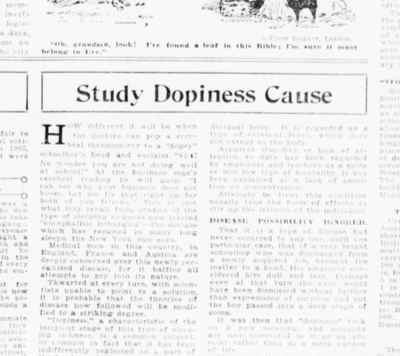100 years ago: Scientists suggest ‘dopiness’ in children might be caused by disease

Scientists were beginning to think that “dopiness” was not just a moral failing of a reluctant schoolboy, but perhaps part of a disease.
“How different it will be when the doctors can pop a cerebral thermometer into a ‘dopey’ schoolboy’s head and exclaim, ‘62.4! No wonder you are not doing well at school!’” said a feature in The Spokesman-Review. “At the businessman’s cerebral reading, he will gasp, ‘I can see why your business does not boom. Let me fix that right up for both of you fellows.’”
This was the result of new research into the terrifying disease of encephalitis lethargica, commonly called sleepy sickness (as opposed to the unrelated “sleeping sickness”).
This disease – which had arrived recently in Spokane – often began with an initial stage of “dopiness,” defined as “apparent stupidity or lack of attention to duty.” As it progressed, this dopiness turned into long bouts of sleep and sometimes death.
Now, scientists were theorizing that there were various degrees of encephalitis lethargica, and dopiness defined the mild form.
“That it is a type of disease had never occurred to anyone until one particular case, that of a very bright schoolboy who was discharged from a newly acquired job, brought the matter to a head,” said the story.
His employer considered him dull and lazy. But he later went into a deep coma, proving he had been suffering from the disease all along.
An epidemic of the disease was currently sweeping the world, and would recede by 1926.